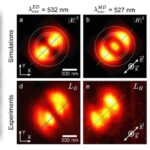Manipulating the Magnetic Part of Light
par Benoît REYNIER,
Sorbonne Université, Institut des Nanosciences de Paris
Mardi 14 Janvier, 11h – Amphithéâtre de l’ISMO
Light-matter interactions are often viewed as primarily driven by the electric field, with the magnetic component frequently overlooked. However, the magnetic field plays a critical role in numerous optical processes, such as chiral light-matter interactions, photon avalanching, and forbidden photochemistry, highlighting the importance of controlling magnetic processes in optical phenomena.
This seminar will focus on my thesis work, which investigates the magnetic component of light from multiple perspectives, establishing it as an exciting new degree of freedom in light-matter interactions. Specifically, by controlling the spatial distributions of the electric and magnetic fields in the intermediate-field through standing waves [1] and in the near-field via localized plasmons [2], we demonstrate the selective manipulation of the coupling between the electric or magnetic component of light and matter, both at the excitation and emission. Moreover, building on this expertise, we are also studying and manipulating complex optical systems, such as Tm³⁺-doped avalanche nanoparticles. These systems exhibit a non-linear electric and magnetic response to the excitation source [3], similar to self-organized criticality phenomena like earthquakes or civil revolution [4], which display avalanche-like behavior. This makes them promising probes for studying these exotic, potentially multidisciplinary effects.
Finally, on the same theme, I will present a theoretical study of a new type of photonic antenna that behaves like a magnetic monopole, operating from the visible range down to GHz frequencies [5]. This once again underscores the significance of exploring and manipulating the magnetic component of light at various spatial scales to harness its potential for a wide range of applications.

Figure 1: (left) Standing wave generation with a SNOM set-up, allowing the controlled electric or magnetic excitation and emission. (center) Luminescence images of the electric and magnetic distributions, consistent with the simulated plasmonic fields. (right) A new designed antenna which behaves like a magnetic monopole.
[1] Reynier, B. et al. Full Control of Electric and Magnetic Light–Matter Interactions through a Nanomirror on a near-Field Tip. Optica 2023, 10 (7), 841. https://doi.org/10.1364/OPTICA.486207.
[2] Reynier, B. et al. Nanoscale Control over Magnetic Light-Matter Interactions. arXiv preprint arXiv:2402.00666, 2024
[3] Lee, C et al. Giant Nonlinear Optical Responses from Photon-Avalanching Nanoparticles. Nature 2021, 589 (7841), 230–235. https://doi.org/10.1038/s41586-020-03092-9.
[4] Moussaid, M. Combien faut-il de personnes pour lancer UNE RÉVOLUTION ? ✊✊✊ – YouTube. https://www.youtube.com/watch?v=Y-1qLR2w60M&t=615s&ab_channel=Fouloscopie
[5] Reynier, B. et al. A Magnetic Monopole Antenna. ACS Photonics 2023, acsphotonics.3c00423. https://doi.org/10.1021/acsphotonics.3c00423.
